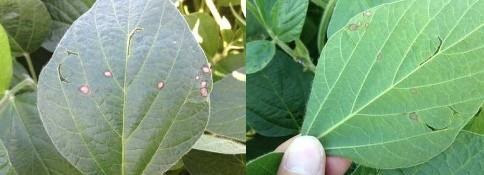Frogeye Leaf Spot: Early symptoms on new leaves.
Northern Ohio and North Central Ohio farmers need to focus on Sclerotinia as we move into flowering. Southern Ohio producers also have something to focus on, scouting for frogeye leaf spot. There are still a few very high yielding but very susceptible cultivars planted in Ohio and it is the susceptible ones that we are most concerned about. Losses of 35% have been reported when the disease starts early and we have consistent, weekly rains. Another complication in the frogeye story, Ohio has a mixed population, some strains are still susceptible to the strobilurin class of fungicides while other strains are resistant, and some fields have both. We do have funding this year from Ohio Soybean Council to evaluate the strains for sensitivity to strobilurin fungicides. So if you have some samples, please mail them to us and we will test for sensitivity to strobilurin fungicides. This is done through the use of molecular markers which are targeted directly to the most common mutation that is known to occur for resistance development. These markers were developed by another group, led by Dr. Carl Bradley, that was funded through a United Soybean Board and Illinois Soybean Association.

The fungus that causes frogeye leaf spot, Cercospora sojina, infects new leaves. So as you are scouting your fields, look in the top 1/3 of the canopy. As new infections start, there are only a few spots scattered around the plants. At Western and here in Wooster, I typically will scout my fungicide trials at 50’ intervals. In the early part of the season, I am lucky if I can find one spot – but this will be enough to measure yield differences at the end of the season. This disease is polycyclic, meaning that everytime the moisture conditions are right, more leaves will be infected from the conidia produced on the older leaves. The spores of this fungus are produced on the underside of the leaf so if in the center of the gray colored lesion, it looks like is has whiskers – those are the spores of Cercospora. If the lesion is more tan, and there are black dots on the top scattered throughout the lesion, that is Phyllosticta, and is usually very minor. If on the bottom it looks white and stringy, that is downy mildew and none of the fungicides have worked on this nor do we any indication that it actually causes a yield loss. And finally, if there are no spores, the tissue is flat, even after letting it sit in a plastic bag overnight, this could also be herbicide injury. I’ve also seen where foam markers can sometimes leave round spots on leaves.
Monitoring for changes and shifts in fungicide sensitivity is critical for correct recommendations for fungicides. My colleagues to the south have eliminated strobilurin fungicides from the recommendation lists since all of their populations are now resistant. At the end of 2017, we had fields that were sensitive, resistant but most were a mixture of both. Stay tuned as we scour the state for samples and get the testing done.